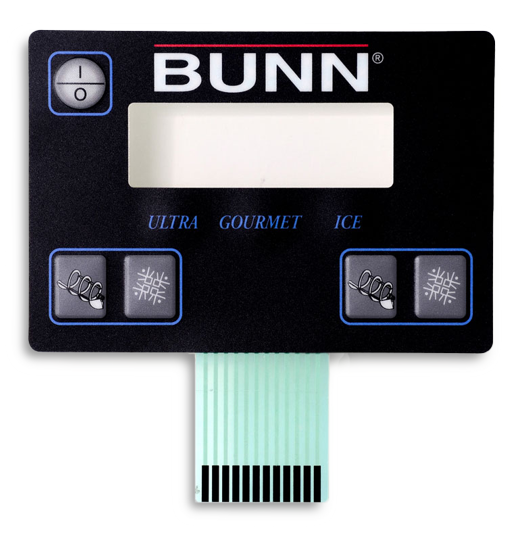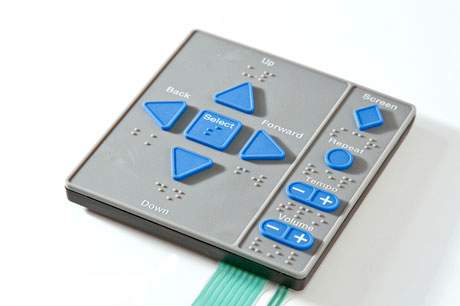Cutting-Edge Technology from a Expert Membrane Switch Manufacturer
Cutting-Edge Technology from a Expert Membrane Switch Manufacturer
Blog Article
Checking Out the Manufacturing Process of Membrane Switch for Various Industries
The manufacturing procedure of Membrane buttons is a complex endeavor that requires accuracy and interest to detail. From selecting appropriate products to applying extensive quality control measures, each action plays a crucial duty in ensuring capability. Different industries, consisting of medical and automobile, depend on these components for their unique applications. Recognizing the ins and outs of this process discloses considerable insights into just how these switches are generated and their effect throughout diverse markets.
Understanding Membrane Changes: A Review

Secret Materials Utilized in Membrane Switch Production
In Membrane button manufacturing, the option of vital materials substantially influences performance and durability. Conductive products, adhesives, and coatings play crucial duties, while substrate choice affects general efficiency and reliability. Understanding these parts is vital for enhancing the layout and production of Membrane buttons.
Conductive Materials Overview
Conductive materials play a crucial duty in the functionality of Membrane buttons, ensuring reputable electric connections within the gadget. Commonly used materials consist of silver, copper, and carbon-based inks, each offering distinctive advantages. Silver is favored for its high conductivity and resilience, making it excellent for applications requiring durable performance. Copper, while somewhat less conductive than silver, is a cost-effective choice often made use of in printed circuits. Carbon-based inks give a flexible alternative, appropriate for applications where flexibility and reduced expenses are prioritized, although they have lower conductivity compared to metal choices. The selection of conductive materials straight impacts the overall integrity, life-span, and efficiency of the Membrane button, making it an essential factor to consider in the production procedure.
Adhesives and Coatings
Adhesives and coatings are vital elements in the manufacturing of Membrane switches, giving vital bonding and safety residential properties. These materials guarantee that numerous layers of the button, including graphic overlays and wiring, stick safely to each other, enhancing resilience and functionality. Commonly made use of adhesives include pressure-sensitive adhesives (PSAs) and epoxy-based formulations, which offer solid bond and resilience. Coatings, such as polyurethane or acrylic, offer to shield against environmental aspects, including moisture, abrasion, and chemicals. In addition, coatings can boost tactile comments and aesthetic appeal, adding to the overall individual experience. The option of appropriate adhesives and finishes is important for enhancing efficiency and durability in diverse applications throughout various sectors, making certain that Membrane switches fulfill particular functional demands.
Substratum Selection Variables
Substrate option plays a crucial function in the production of Membrane buttons, as it greatly affects their overall efficiency and sturdiness. Trick materials such as polyester, polycarbonate, and adaptable printed motherboard (FPCBs) are generally used for their distinctive properties. Polyester is favored for its cost-effectiveness and resistance to abrasion, making it ideal for applications with high wear. Polycarbonate offers remarkable quality and impact resistance, suitable for settings requiring high exposure. FPCBs provide enhanced versatility and are often utilized in intricate layouts. The choice of substrate likewise influences variables like thermal stability, chemical resistance, and ease of printing. Eventually, picking the ideal substrate is vital for making sure the capability and longevity of Membrane switches across various industries.
The Design Refine of Membrane Switches Over
The layout procedure of Membrane buttons is a vital phase that considerably affects the capability and aesthetics of the final product - membrane switch manufacturer. It begins with defining the specific requirements of the application, consisting of measurements, switch format, and responsive comments preferences. Designers must take into consideration customer interaction, guaranteeing that the switch is user-friendly and accessible.Next, materials are selected based on resilience, versatility, and ecological resistance. The assimilation of graphics and branding elements is additionally crucial, as it enhances visual appeal and interaction. Prototyping allows for repetitive screening, making it possible for changes based on user responses and efficiency evaluations.Additionally, the layout needs to represent the electrical elements, such as ports and circuits, guaranteeing dependability and convenience of usage. Inevitably, an effective style integrates capability, looks, and individual experience, paving the way for effective production and long-lasting efficiency in various markets
Printing Techniques for Membrane Switches
The printing strategies used in Membrane button manufacturing play a vital role in establishing the end product's top quality and performance. Display printing uses advantages such as toughness and dynamic shade application, while electronic printing developments give flexibility and accuracy in design. Recognizing these techniques can considerably impact the general efficiency of Membrane switches in numerous applications.
Screen Printing Advantages
Numerous benefits make display publishing a favored method for generating Membrane switches. This method enables for top notch, comprehensive styles and lively shades, which are crucial for user interface applications. Screen printing is specifically effective for using thick ink layers, boosting durability and responsive feedback. Furthermore, it uses this link superb attachment to numerous substratums, guaranteeing durability in demanding atmospheres. The process is affordable for large production runs, as it minimizes setup time and waste. Display printing sustains a large array of inks, including specialty and UV-curable options, enabling versatility in design. Its capability to produce regular results across multiple systems makes it a trusted selection for makers going for top quality and effectiveness in Membrane button production.
Digital Printing Innovations

Improvements in digital printing modern technology are transforming the manufacturing of Membrane switches, using suppliers cutting-edge options that boost design versatility and efficiency. Digital printing allows for elaborate designs and high-resolution graphics, go to website allowing personalized branding and performance without the constraints of conventional approaches. This technique minimizes arrangement times and costs, promoting much shorter production runs and very little waste, making it ideal for services with differing demands. Additionally, improvements in ink solutions provide better resilience and attachment, ensuring durability in various settings. As sectors progressively look for tailored and complex styles, electronic printing stands apart as an important method, setting a brand-new requirement in Membrane button manufacturing. The integration of these developments settings manufacturers to meet advancing market needs efficiently.
Setting up and Layering of Membrane Switch Parts
Cautious setting up and layering of Membrane switch components are necessary to ensuring performance and sturdiness. This process begins with the exact alignment of different layers, consisting of the visuals overlay, glue, circuit layer, and support product. Each component must be carefully placed to keep electric integrity and interface responsiveness.During assembly, conductive traces are related to the circuit layer, usually made from materials like polyester or polycarbonate. This layer is vital, as it transfers signals when pressure is applied. The glue utilized for bonding these layers is likewise picked for its capacity to endure ecological tensions while maintaining a safe and secure bond.Heat and stress are usually used throughout the assembly procedure to establish that the layers adhere effectively without jeopardizing the capability of the switch. Attention is offered to the edge securing to safeguard versus dampness and impurities, safeguarding the longevity of the Membrane switch in different commercial applications.
Quality Assurance Measures in Membrane Switch Production
Quality control procedures play an essential duty in making certain the reliability and performance of Membrane switches following the setting up and layering of their parts. In the manufacturing procedure, numerous crucial evaluations are carried out to copyright high quality criteria. These consist of aesthetic examinations for defects in printing and sticky application, as well as useful examinations to validate the responsiveness of each switch.Additionally, environmental testing is done to examine the buttons' durability versus temperature level changes and humidity exposure. Suppliers typically execute statistical process control (copyright) techniques to keep an eye on production consistency, making it possible for early discovery of anomalies.Furthermore, traceability systems are established to track products and elements, guaranteeing responsibility and promoting remembers if needed. Calibration of tools and adherence to sector criteria are also important to preserving item honesty. Collectively, these top quality control steps safeguard the performance of Membrane switches across different applications, ultimately enhancing consumer fulfillment.
Applications of Membrane Changes Throughout Different Industries
Membrane switches are made use of across a diverse variety of sectors, showcasing their versatility and flexibility. In the clinical sector, they offer water resistant and trustworthy interfaces for gadgets such as analysis equipment and mixture pumps, making sure hygiene and convenience of usage. The auto industry uses Membrane buttons for dashboard controls, allowing seamless interaction in between the vehicle driver and vehicle systems.In customer electronic devices, these switches are found in home appliances and portable devices, offering a streamlined, modern visual while boosting functionality. Industrial applications likewise leverage Membrane changes for equipment control panels, where sturdiness and resistance to rough conditions are essential.Furthermore, the aerospace and defense industries use Membrane switches for cockpit instrumentation and communication systems, prioritizing reliability and performance under extreme conditions. Overall, Membrane switches play a vital duty in boosting the individual experience and operational effectiveness across various domains.
Often Asked Questions
Exactly how Lengthy Does It Take to Manufacture a Membrane Switch?
The production time for a membrane layer button normally varies from a few days to several weeks - membrane switch manufacturer. Variables influencing this period consist of layout intricacy, material schedule, and production quantity, all influencing the total timeline significantly
What Is the Typical Life Expectancy of a Membrane Layer Switch?
The normal life expectancy of a membrane switch typically ranges from 1 to 5 million actuations, relying on more tips here elements such as material top quality, environmental conditions, and usage frequency, considerably impacting longevity and general performance.
Can Membrane Switches Over Be Customized for Specific Applications?
Membrane switches can certainly be personalized for particular applications. Their style flexibility allows for changes in size, form, shades, and graphics, making certain compatibility with unique requirements throughout various markets and improving functionality and customer experience.

Are Membrane Switches Over Eco Friendly?
The ecological influence of Membrane switches over differs. Some products used might not be eco-friendly, while innovations in manufacturing procedures are progressively focusing on sustainability, intending to lower waste and promote recyclable elements in their production.
What Are the Usual Failure Settings of Membrane Buttons?
Usual failure modes of Membrane buttons consist of delamination, glue failing, damage from usage, dampness access, and electric failures. These problems can greatly influence capability, efficiency, and life-span in various applications throughout different industries. Membrane switches can be personalized to fit details design requirements, such as functionality, shape, and dimension, making them highly adaptable.The construction normally includes several layers, including a graphic overlay, adhesive, and a circuit layer, which function together to create a seamless user experience. In Membrane button manufacturing, the option of key products greatly influences functionality and toughness. The automotive sector employs Membrane switches for control panel controls, making it possible for seamless communication between the chauffeur and lorry systems.In consumer electronics, these switches are discovered in devices and portable gadgets, providing a sleek, modern visual while boosting capability. Industrial applications also utilize Membrane switches over for equipment control panels, where resilience and resistance to rough problems are essential.Furthermore, the aerospace and protection industries make use of Membrane switches for cabin instrumentation and communication systems, prioritizing dependability and performance under severe problems. Membrane switches can certainly be personalized for specific applications.
Report this page